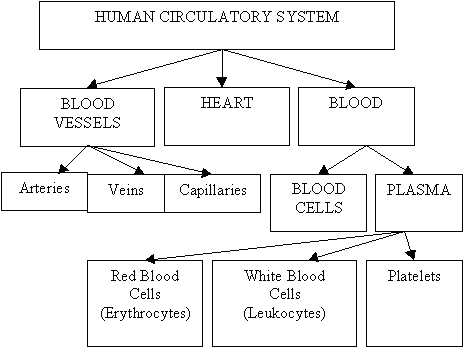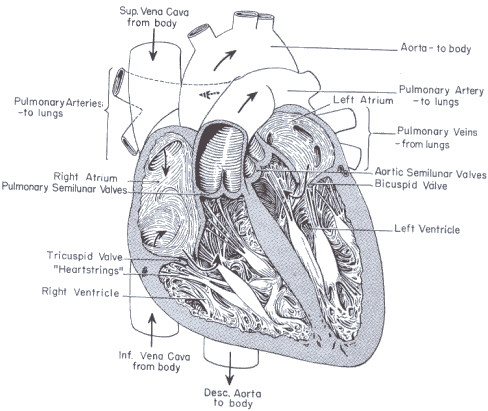

BLOOD
- Blood contains the fluid part called Plasma, and many blood cells
- Plasma is a yellowish, slightly alkaline liquid that comprises 55% of blood, and is a mixture of nutrients (amino acids, sugars, fatty acids, glycerol, salts), hormones, antibodies, enzymes and some dissolved gases in water
- Red Blood Cells (Erythrocytes) are made in the bone marrow in the centre of certain long bones. Red blood cells have nuclei when first formed, but lose their nuclei when mature. They live only about 4 months before being destroyed by the spleen and the liver. Red blood cells contain a red chemical called haemoglobin, that attaches either to oxygen or carbon dioxide molecules to transport them around the body.
- White Blood Cells (Leukocytes) are made in bone marrow and the spleen. They live only 2 to 4 days, because their purpose is to fight infection. They either surround and ingest foreign particles or bacteria (macrophages that perform phagocytosis), or produce chemicals such as antibodies and antitoxins to neutralise the invading particles or bacteria.
- Platelets are small disc-shaped blood cells without a nucleus. They are formed in bone marrow, and play an important role in the clotting of blood.
BLOOD VESSELS
- Arteries take blood away from the heart. They usually contain blood rich in oxygen. Arteries have elastic muscular walls that can dilate and constrict as each pulse of blood goes through.
- Veins take blood back to the heart. They contain valves that allow a one-way flow of blood. Veins are less muscular than arteries.
- Capillaries are the smallest and most numerous of blood vessels. The capillary diameter is only the width of one red blood cell, so blood travels slowly through capillaries. The capillary wall is only one cell thick to allow exchange of nutrients and oxygen into, and wastes such as carbon dioxide out of the body cells.
STRUCTURE OF THE HEART

- The heart is a strong muscular organ used to pump blood.
- It has 4 blood-collecting chambers - 2 atria and 2 ventricles.
- Valves between the chambers allow one-way blood flow.
- The wall of the left ventricle is the thickest and strongest because blood from here is pumped all around the body.
- The heart has its own blood supply via the coronary artery. If this is blocked, a 'heart attack' may occur.
BLOOD FLOW THROUGH THE HEART
- Oxygenated Blood - contains a lot of oxygen but very little carbon dioxide
- Deoxygenated blood - contains very little oxygen bit a lot of carbon dioxide
- Direction of Blood Flow - Blood from body - Vena Cava - Right Atrium - Right Ventricle - Pulmonary Artery - Lungs - Pulmonary Veins - Left Atrium - Left Ventricle - Aorta - All body cells